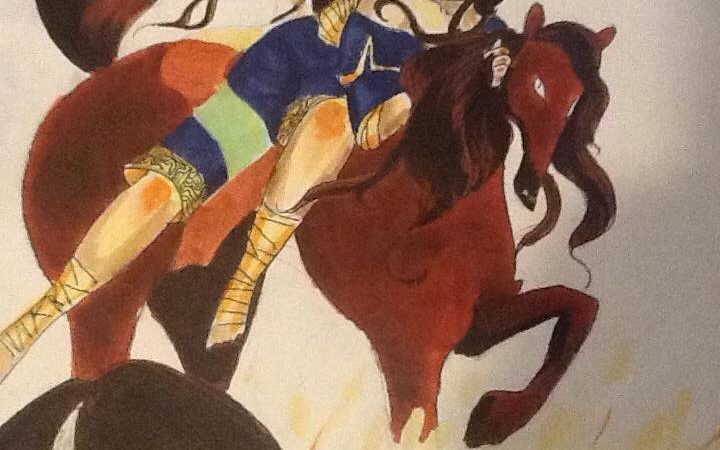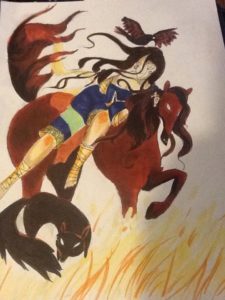 Sometimes people ask me how I world build. That’s a tough one. As Jane Lindskold quoted—to my amusement—something I’d said in a chat, “I have a lot of joy in what I write, but it’s not like I write about vampires or YA Post Apocalyptic stuff. I write these weird aggregated world culture/mythos mashes that are allegories.” (It was a great blog, by the way, her “Who are you Writing For?” It is good enough to share, which is why I didn’t just say what I’d said, but it adds to my amused context in saying it here). The latest books I’ve been working on are, in fact aggregates of a number of different influences. Two main ones are Ndembu healing rituals, and Etruscan Mythology. Those are, quite easily, not two cultures one might easily put together. I’m crazy for having done it, and possibly crazier for the belief that I made it work.
Sometimes people ask me how I world build. That’s a tough one. As Jane Lindskold quoted—to my amusement—something I’d said in a chat, “I have a lot of joy in what I write, but it’s not like I write about vampires or YA Post Apocalyptic stuff. I write these weird aggregated world culture/mythos mashes that are allegories.” (It was a great blog, by the way, her “Who are you Writing For?” It is good enough to share, which is why I didn’t just say what I’d said, but it adds to my amused context in saying it here). The latest books I’ve been working on are, in fact aggregates of a number of different influences. Two main ones are Ndembu healing rituals, and Etruscan Mythology. Those are, quite easily, not two cultures one might easily put together. I’m crazy for having done it, and possibly crazier for the belief that I made it work.
I think I could more easily describe why it works if I can show off two different images—not that one is Etruscan, but it is Bronze age, and skirts the Mediterranean. I was binging on Bettany Hughes videos (yes, I was binging on archaeology and anthropology videos), and one of them was about Helen of Troy. In the video a makeup artist took images from an ancient Bronze Age statue, and made up a model to look like that sculptured past. Sadly, I could not find images on Bettany Hughes’ site.
I did find it on another. Kala Ksetram’s tumbler site shows not only the modern image, but also the old painted statue.
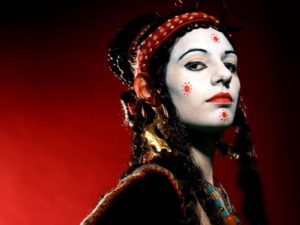
Another image, taken off a site that echoes the image from Victor Turner’s The Forest of Symbols, but in a surprising essay comparison to Indian rituals. The essay does describ e a few of the rituals described in Turner’s book if you want a quicker read. Granted, this image is of boys who will soon be men. Not a Ndembu Helen.
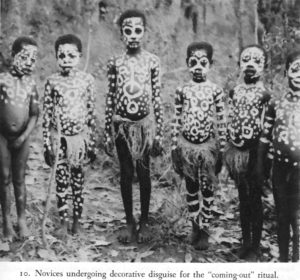
But if we venture, still in Africa, here’s another, that has echoes of our Helen of Troy. A woman from Mauretania. The image was found on another tumbler site, but it is from Angela Fischer’s Africa Adorned p. 221 (a wonderful book with glorious images and discussion about their art and culture). 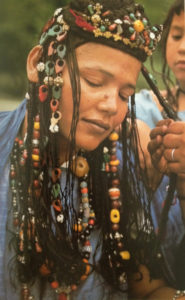
I’m not sharing these images because I see any kind of direct link with each other. They are there to show that there are commonalities in these ancient and modern cultures—even our own.
I do what could be called research. I often call it going down the rabbit hole.
Think of passages or images in various books or videos already mentioned, and in this case add Larissa Bonfante and Judith Swaddling’s Etruscan Myths in the Legendary Past series.
I’ll admit that I used the image of the modern made up Helen—even though that inspiration came long after my initial blending of Etruscan myth and landscape with Ndembu and Great Zimbabwe. I was fascinated by the sculpture of women in Etruria. And that led me down a rabbit hole blending the echoes of ancient Etruscan clothing, with an image of a woman from the 1700s who wore an outfit that had echoes of the current high fashion, but with clear echoes of what might be considered a more Italian, but provincial style.
Each of those thing—images, passages describing myth or ritual—are like pebbles thrown into a still pond. They ripple. Throw them all at different times, and those ripples all blend together to make another pattern. Within those patterns I find something, and draw it out. I sometimes hear it, or see it, and even taste it—when there’s food involved. I let the power of those passages, or images reverberate in my mind and let them be till they find new life on the page.
It’s the awe of our absolutely incredibly vibrant and varied world that fascinates me, and fuels me. I believe that it is my joy in our world, or rich world that is part of the fuel that inspires me to write.
It’s possible that those images (and cultures and rituals and gods)—and the fact that I’d have the temerity to blend them—might still seem bewildering. But there’s also something deep and rich within all those different aspects of our world. As unique and special as each are, and they truly are, there is always something within us that we can respond to, and celebrate with the other. It is perhaps—I hope—that which helps me glue these disparate parts and create an aggregate, but whole world in my writing.
